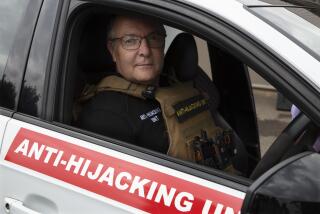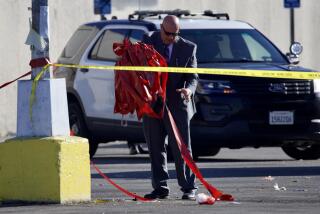Traditionally Safe Sweden Is Jolted by Spate of Violent Crimes
- Share via
STOCKHOLM — Brutal robberies, rapes and assaults have shocked Sweden, which used to pride itself on the safety of its streets.
In one case, a gang of youths robbed and kicked to death an elderly woman in a schoolyard. In another, three young men were jailed for beating to death a victim who refused to give them his bank-card number. In another incident, a youth was butchered with a broken bottle.
“It is the ferocious nature of these attacks that has caused the present debate,” said Karin Jonsson, a sociologist and Stockholm city councilwoman.
Swedes are agonizing over demands for more law and order and trying to understand the causes of the new crime wave that has caused many citizens, especially women, to fear walking the streets at night.
“We do not accept violence in this form in our cities,” said Prime Minister Ingvar Carlsson’s press secretary, Marita Ulvskog. “When somebody is beaten up or raped, it is a big deal in Sweden, maybe because we are a small country.”
Irma Lilliendahl, daughter of the woman murdered in a schoolyard, collected almost 100,000 signatures of people protesting against violence and led a demonstration through central Stockholm recently.
“We cannot leave responsibility for dealing with violence to the politicians,” she told a rally. “We must all take responsibility. We must look after each other.”
Police received 4,226 complaints of outdoor assault in the first nine months of this year, 477 more than in the same period in 1988.
Carlsson told a news conference that part of the problem is that parents do not take enough responsibility. He also backed calls for more police officers to patrol the streets on foot.
National Police Chief Bjorn Eriksson believes 700 more officers are needed to control the problem, a view shared by conservative Moderate Party leader Carl Bildt.
Bildt demanded tougher penalties for first-time violent offenders, adding: “We must learn--in school, the family and in society--the difference between right and wrong.”
Alcohol, drugs, violence on television and immigration are blamed as the main causes of the recent violence. But politicians cannot agree on whether the welfare state is doing too much for the mainly young offenders, or not enough.
Karin Jonsson said she is convinced that alcohol is the root of the problem.
“There are several reports in Sweden showing that when strikes affected the distribution of alcohol, violence fell,” she said. “Between 70% and 80% of young people involved in fights are drunk.”
One proposal is to raise from 18 to 20 the minimum age for consumption of alcohol on licensed premises. Swedes already have to be aged 20 to buy liquor at the state monopoly shops.
Youth Minister Margot Wallstrom has announced that she will propose legislation to provide stiffer penalties and to tighten up the sale or rental of prerecorded videos considered violent.
“I cannot understand why we allow such videos in the first place,” Jonsson said. “It is a purely commercial operation. They are bound to have an impact on young people.”
On a politically sensitive issue, Stockholm police figures showed that men of foreign extraction were responsible for two-thirds of assault cases solved by police.
Criminologists say immigrants are over-represented in Sweden’s indexes of social deprivation, such as unemployment and inadequate housing.
In the first nine months of this year, 48,700 people migrated to Sweden, 30% more than in 1988 and the highest number since 1970. Iran with 5,600 was the leading country of origin, followed by Chile with 4,800, Norway with 4,300 and Ethiopia, Poland and Yugoslavia with 1,200 each.
Leif Persson, a criminologist who is chairing a government commission on the problem, told a news conference: “Violence is more or less built into the society we live in, but one must always try to root it out.”
More to Read
Sign up for Essential California
The most important California stories and recommendations in your inbox every morning.
You may occasionally receive promotional content from the Los Angeles Times.













